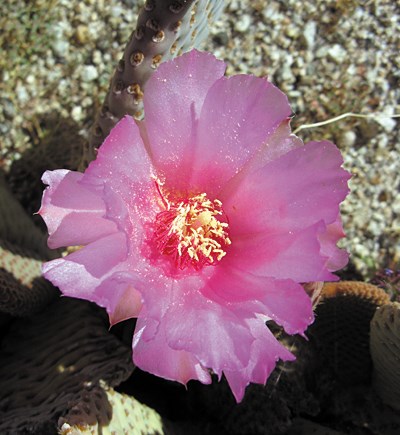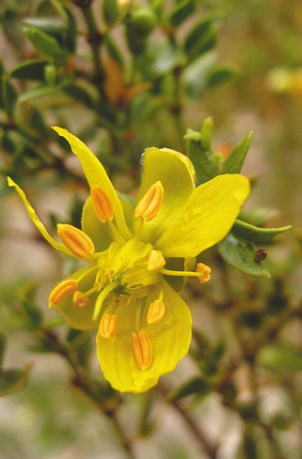
NPS / Brad Sutton Trail InformationThis short trail (0.5 mi/0.8 km) is located in Twentynine Palms at the Joshua Tree National Park Headquarters. This oasis is unique within the Park due to the more alkaline conditions, the large stand of honey mesquite, and the surrounding playas and fans dominated by desert saltbush and burrobush, which prefer heavier soils. This flat paved loop is the most accessible place to view the California fan palm, as well as a number of plant species found in very few places in the park, such as arrow-weed and Mojave seablite. Along the way, interpretive signs introduce visitors to the historical significance and local ecology of this site, and there are several places to sit down and enjoy the view.
NPS / Brad Sutton An Ethnobotanical PerspectiveMany people think of landscapes as being either natural or human-influenced, and imagine a clear distinction between the two. A cultivated garden is human made, this thinking goes, and a landscape dominated by native desert species is natural. Reality is more complicated. Most landscapes on Earth have a long history of human use and management. The Oasis of Mara is a great example: people have used the fresh water and natural resources present here since time immemorial.“Mara” is the name given to this place by the Serrano people, whose traditional songs describe the area around the oasis as their first home in this world. The deergrass (Muhlenbergia rigens) that still grows at the base of the palms was one of the most important basketry materials in California. Arrow-weed (Pluchea sericea) was used for making hunting arrows and large, woven containers. Some of these held the copious amounts of pounded mesquite beans harvested each year in late summer. People have long gathered the fruit of palm trees, used palm fibers for baskets or shoes, and employed large palm leaves as thatch for homes. Native Americans periodically burned the palm groves to control for the palm borer beetle, stimulate new fruit production, and encourage deergrass growth. While surveying the area in 1855, Colonel Henry Washington (George Washington’s nephew) noted the presence of cultivated rows of indigenous American crops such as corn, beans, and squash. These crops were supported by abundant water that used to rise to the surface at this oasis. Today, coyotes eat the fallen palm fruit and birds flit among the mesquite. People enjoy the shade, much as they have for centuries. The landscape you see at the Oasis of Mara evokes many stories; this is a place that is—and long has been—both natural and human-influenced. 
California Fan PalmWashingtonia filiferaFebruary–June One of the quintessential members of any oasis, these majestic trees indicate the presence of water. Remnants of a more subtropical time when forests of palms were widespread, you can now find them only in isolated areas that have permanent water sources. Palms may keep their dead leaves hanging for many years. The resulting petticoats or skirts of old fronds help to protect the trunk during fires and are home to many species of wildlife. 
James Andre Desert StarvineBrandegea bigeloviiMarch–May A native member of the cucumber family, you will find this scrambling vine climbing over and around shrubs and other vegetation, particularly along washes where its deep taproot can access seasonal water. The small fragrant white flowers emerge after rains in the spring or summer. The plant climbs using unbranched tendrils; the green leaves have long finger-like lobes and white oil glands dotting the upper surface. The fruit is dry and prickly. 
Steve Matson Desert SaltbushAtriplex polycarpaJuly–August You will find this species thriving in salty soils, such as alkali sinks and playas. Like many members of this genus, the desert saltbush has the ability to accumulate salts in bladder-like leaf hairs. Eventually these hairs burst and discharge salt granules onto the leaf, giving it a blistered or shredded appearance. 
DeergrassMuhlenbergia rigensJune–September The Oasis of Mara is a place that has been intricately tied to people for thousands of years. Many of the plants that you see around you were used in a variety of ways, and deergrass is no exception. The most recognized use of this species was for making coiled baskets with the flowering stalks. This practice was widespread among California’s Native Americans, and resulted in careful cultivation and management practices to help promote the growth of the plant. 
Beavertail CactusOpuntia basilarisMarch–June This cactus has flat, bluish gray pads that are spineless and appear fuzzy and soft, tempting people to make the mistake of touching them. Beware: instead of spines, they are armed with many small bristles known as glochids, which are painful and very difficult to remove! The species name basilaris means regal, referring to its beauty when covered with the large, nearly neon pink flowers. Ants can often be found swarming the newly formed pads and flowers due to the copious amounts of nectar they produce. Native Americans traditionally used beavertail cactus for both food and medicine. 
BurrobushAmbrosia dumosaDecember–June Burrobush and creosote bush dominate basins and fans of fast-draining gravelly soil throughout the desert Southwest. Like creosote bush, this compact shrub is long-lived— up to 75 years! Flowers of the genus Ambrosia are small and hard to recognize, but the spiny burs are easy to spot. The wind-blown pollen of this genus is perhaps its most recognized feature, as it is often the culprit for springtime allergies. 
Creosote BushLarrea tridentataApril–May Perhaps the most widespread perennial of the North American deserts (except the Great Basin Desert) is the creosote bush. This evergreen species is best known for its ability to grow into ancient clonal rings (some over 10,000 years old), making it one of the longest living organisms on earth! Loaded with heavy oils and toxic alkaloids, creosote bush is well protected against herbivores and aridity. However, many gall-forming insects have adapted to its toxins, and some animals, such as the desert iguana (Dipsosaurus dorsalis), take advantage of less toxic tissues like the flower petals. 
Mojave SeabliteSuaeda nigraMay Mojave seablite is a salt tolerant species, also called a halophyte (“salt-lover”). Worldwide, you can find this genus growing on beaches or in highly saline habitats, e.g. coastal salt marshes. This species collects salt in its leaves and sheds them, increasing the salinity of the soil and thereby preventing other less salt-tolerant plants from growing nearby. This particular species secretes a black dye, which was used by Native Americas to color baskets. 
Honey MesquiteProsopis glandulosaApril–August Mesquite has a long and rich history of human use. Native Americans have used every part of this plant; examples include using the roots for fiber, leaves for tea, or collecting the black oozing pitch from the trunk for hair dye or pottery paint. They harvested and consumed the pods in a variety of ways, often pounding them into fine flour and baking rolls and cakes. Mesquite roots can reach water more than 60 feet below the surface, making mesquite a phreatophyte, a plant that has its roots constantly in contact with the phreatic zone (water table). 
Barrel CactusFerocactus cylindraceusApril–May When immature the barrel cactus has an almost round shape, but as it grows it assumes a more columnar appearance. Reaching up to nine feet in height, you’ll often find barrel cacti on southern slopes and frequently leaning toward the sun. The yellow flowers form a ring around the top of the plant, resembling a crown. Barrel cacti are heavily harvested for sale as horticultural specimens and to make cactus candy. Within the park, however, plant harvesting is prohibited. 
Silver ChollaCylindropuntia echinocarpaMarch–July A silver colored papery sheath surrounds the abundant spines of this cactus species, thus its common name. If you look inside the flowers, which are yellow with a greenish tint, you’ll see numerous stamens and abundant pollen—a common trait in the cactus family. The fruit forms from an ovary deeply recessed in the stem and matures from within this receptacle, which is why the fruits also have spines or barbed hairs. 
Arrow-weedPluchea sericeaMarch–June As the name indicates, the long, straight stems of this species were used to make arrows. It was also used for making baskets, cages and storage bins. Like many other members of this genus, arrowweed has a unique scent and was used for a variety of medicinal purposes. It can form dense thickets in low washes or canyons throughout the North American deserts, but you’ll only find it in two locations in Joshua Tree National Park. 
Desert MistletoePhoradendron californicumJanuary–March The reddish stems you see growing on honey mesquite produce the main food source for the Phainopepla , a large black or gray bird with a feathered crest. The desert mistletoe produces very sticky berries that can pass unharmed through the digestive tracts of these birds. When the bird excretes the mistletoe’s indigestible seeds, the small mound of sticky, red pulp clings to the branches. If the seeds germinate on a suitable host plant, the mistletoe will attach itself with specialized “roots.” It’s a win-win: the mistletoe provides food for the Phainopepla, and the bird helps disperse the plant’s seeds. |
Last updated: February 15, 2023
